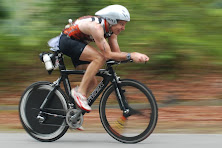(Courtesy of Joe Friel's blog http://www.joefrielsblog.com)
Simon Says: -
Mmm, this sounds familiar!
Mmm, this sounds familiar!
 One of the common problems of triathletes in long-course races and runners in marathons is “stomach shutdown.” This commonly happens starting around half way into the bike leg or sometimes as the run starts in a triathlon. Marathoners may also experience it about half way into the race.
One of the common problems of triathletes in long-course races and runners in marathons is “stomach shutdown.” This commonly happens starting around half way into the bike leg or sometimes as the run starts in a triathlon. Marathoners may also experience it about half way into the race.
When the stomach shuts down the feeling athletes experience is that nothing they take in passes through the gut. It just sits there causing a bloated and sometimes nauseous feeling. The most common method for dealing with this is to slow down and quit taking in anything until the bloating and nausea subside. Vomiting sometimes helps. When the bloated feeling begins to let up athletes will usually try plain water to see how that is processed. If that works then they gradually increase the effort as more substantial food sources are reintroduced. But by this time race goals are usually too far gone and motivation begins to subside.
Why me?
So what is “stomach shutdown” and what causes it? Assuming the cause is not medical—such as irritable bowel syndrome or vagus nerve damage—the cause more than likely is related to a mismatch between effort and fuel volume or the variability of intensity throughout the early portion of the bike or run. Also generally involved in both of these possible reasons for stomach shutdown is taking in fluids based on some sort of contrived “hydration” schedule. Learning to drink when you are thirsty will resolve this and make such schedules pointless. (I have athletes treat fluids and calories as two separate items in the race, but that’s a whole other discussion I’ll do another day.)
Another common confounding element is the type of food consumed during the race. Fiber-rich foods are slow to digest. Some athletes even have trouble using protein in a sports drink since it slows digestion. As more stuff is put in your gut (water, sugar, protein, fat, electrolytes, fiber, vitamins, minerals, etc) your digestive system is challenged to process it. You will eventually reach the tipping point if you keep taking in what you are told is “necessary” by brand marketers or what seems to work for other athletes and the stomach will shutdown. For long endurance events, the only things that are truly necessary and have been shown to be effective are water and sugar.
Possible Solutions
The best way to deal with this problem is to prevent it. Prevention starts long before race day. In the last 12 weeks prior to the race you should have been doing some racelike workouts in which your planned race-day nutrition was tried. To be “racelike” the workout has to be about half the duration of the race and done at the planned race intensity. Race intensity is the key element here. Rehearsing a nutrition plan at less than race effort is of little value. Try your eating plan in a C-priority race, especially one that’s about half as long as the A-priority race. A racelike workout or actual race should give you a good indication of what may or may not work on the day of your A-priority race.
Even this doesn’t always prevent bloating, however, due to other factors such as a nervous stomach or even swallowing too much ocean water during the swim. So the solution is to use only what you need while staying on the conservative side. If in doubt, eat and drink somewhat less. Plan to take in the lower end of the amount of food you think will be needed—not the most amount. And don’t try anything on race day if you haven’t done it successfully many times before.
Pre-race nutrition can set you up for a stomach shutdown, also. Have breakfast no less than 2 hours prior to the race start. Three hours is better. Eat only what has worked in the past. This also should have been rehearsed at least twice in the last 12 weeks. In the last hour before the race take in nothing but water. Ten minutes before the start use a sports drink or gel with water that you carried to the start line.
Here’s the most important part: If you have a tendency for stomach shutdown start the race slower than you feel like you could go. Much slower. Hold back. Be patient. Do not start the race anaerobically or even close to it no matter how great you feel. I’ve seen athletes anaerobic in the second mile of the bike leg of an Ironman. And they still have 110 miles to go. I’ve heard marathoners gasping for air at the mile 1 marker. What are they thinking?
Let’s look at it this way: If you were walking a marathon very slowly you could eat a Big Mac, French fries, and a milkshake. No problems. But if you were running a one-mile race as fast as you could go it would difficult for your stomach to process a sip of water. So effort is closely tied to digestion. They must match. If you go faster than rehearsed in the early portion of the race but take in fuel and fluids at the rate that worked at a lower effort in training then you have set yourself up for a stomach shutdown. Fuel volume and effort must match.
In a related cause, the athlete may start at an appropriate effort but frequently throughout the race he or she surges as other athletes pass or hills are “attacked.” Success in long-distance events generally requires very little intensity variability. Using WKO+ software we can now measure variability when racing with a power meter or GPS device. What I look for is a variability index (VI) of less than 1.06. I once viewed a triathlete’s Ironman file and saw that he had a VI of 1.25. That’s what I would expect to see in a bicycle criterium with lots of surges out of corners. This not only causes the stomach to shut down, it also wastes energy. He DNF’ed.
Bottom Line
So if you are prone to stomach shutdown some possible solutions are:
•Determine a pacing plan for the race, rehearse it, and then follow it—especially at the start of the race.
•Match the pacing plan with a nutrition plan which you have also rehearsed at race effort.
•Have a pre-race meal several hours prior to the race and take in nothing but water in the last hour—until 10 minutes before the start. And do not over drink at this time. You aren’t a camel. Drink only to satisfy thirst (it works, regardless of what marketers have told you).
•Use only foods and drinks that you have rehearsed at a racelike effort for a long duration many times. These foods should be low in fiber, known to not significantly delay your digestion, and are proven to work for you even if you go slightly too fast at first—because, unfortunately, you are likely to do that even though you know it’s wrong.
•Do not surge in the race. Ride or run at steady effort with only gradual and slight increases for hills.


4 comments:
Great information here. Thanks for sharing this Simon.
Seems obvious but someone people just dont get it.
What you drank/ate in triaining is exactly what you need to do at the race.
So many people try new things or dont follow a TESTED plan during a race. I've overdone it in the shorter races deliberately to see what I could handle, and OH BOY that hurts bigtime. I learned my lessons before the big show, and taught myself how to deal with GI issues if they do surface.
I dont mind those unprepared people though - it just makes my rankings look better :)
great post
M, Yeah it's useful info. You're welcome
J, You're a hard many dude! Glad you're not my coach haha
I, Thanks
Post a Comment